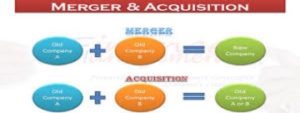Introduction to SEC Filings
Securities and Exchange Commission (SEC) Filings can be made for a variety of reasons. Although in many cases this disparity may require the use of the same form identification, this article will concentrate on the SEC filings made with respect to mergers & acquisitions.
Merger Arbitrage Limited monitors a large number of deals at any one time, many of which appear on our spread tracker list. As these deals progress towards consummation, filings are made with the SEC registering important details and information pertinent to the deal. MAL scours these documents for valuable insights which can give an edge when evaluating the merger arbitrage spread.
SEC Filings Analysis
To assist our fellow traders in merger arbitrage land we have undertaken an analysis of the most commonly used forms in SEC filings for the second half of 2019 by the stocks that we followed until each deal was consummated. This gives us a pretty good analysis of which forms are important, and therefore which forms YOU, dear trader, NEED TO KNOW about. We haven’t included any statistics here, there’s no need. But the top ten (ish) most common forms filed are as follows
- 8-K
- 3 & 4
- DEFA14A & DEFM14A
- 10-Q
- SC 14D9/A
- SC TO-T/A & SC TO-C
- SC 13G/A & SC 13D/A
We omitted the standard post completion filings such as S-8 POS, 25-NSE, 15-12B, EFFECT, POS AM & POSASR amongst others, as these are not considered as relevant to the trading of merger arbitrage. These filings are made after the deal closes and investors would have already moved on to the next trade. Those that are important are listed with descriptions below. We have grouped similar forms together to keep things explanations concise.
Form 8-K
One of the most common forms used in SEC Filings is the 8-K. An 8-K is a report of unscheduled material events or corporate changes at a company that could be of importance to the shareholders or the Securities and Exchange Commission (SEC). The report notifies the public of events such as
- mergers and acquisitions
- auditor news
- earnings announcements
- bankruptcy
- resignation of directors
- change in the fiscal year
An 8-K is required to announce major events relevant to shareholders. Businesses have four business days to file an 8-K for most specified items. One exception to this is Regulation Fair Disclosure (Reg FD) in Section 9 in the Investor Bulletin reporting requirements which may be due earlier.
An organization must determine if the information is material and submit the report to the SEC. This allows for a certain amount of ambiguity. However, The SEC outlines the various situations that require the use of a Form 8-K. There are nine sections within the Investor Bulletin and each of these sections may have between one to eight subsections. The most previous adjustment to Form 8-K disclosure rules occurred in 2004. Once the SEC receives the data, it makes the reports available through the Electronic Data Gathering, Analysis, and Retrieval (EDGAR) platform.
More Information at quick answers on how to read a form 8-K.
Additionally, if you have not already read
“Investor Bulletin: How to Read an 8-K”,
then STOP trading and read it NOW!
Forms 3 & 4
Form 3: Initial Statement of Beneficial Ownership of Securities
Form 3 is a document filed by company insiders or major shareholders. The information provided on the form is intended to disclose the holdings of directors, officers, and beneficial owners of registered companies. As soon as the inside files the information, it becomes public record and is available for public inspection.
The SEC states that disclosure is mandatory. The form is an important part in the fight to regulate insider trading. This is an illegal practice where an individual buys or sells a security based on material non-public information. The filing of Form 3 helps disclose who these insiders are and helps track any suspicious behavior.
More Information at quick answers on how to read Forms 3, 4 & 5.
Form 4: Statement of Changes in Beneficial Ownership
Form 4 is a document that that requires filing whenever there is a material change in the holdings of company insiders. Insiders consist of directors and officers of the company, as well as any shareholders, owning 10% or more of the company’s outstanding stock. The details required on the form include the reporting person’s relationship to the company and about the purchases and sales of such equity securities.
Identical to Form 3, disclosure of information required on Form 4 is mandatory and becomes public record upon filing. The filing of Form 4 relates to Sections 16(a) and 23(a) of the Securities Exchange Act of 1934, as well as Sections 30(h) and 38 of the Investment Company Act of 1940.
Forms DEF 14A, DEFM14A & DEFA14A
DEF 14A Definitive Proxy Statement
The DEF 14A form relates to definitive proxy statements. A DEF 14A is filed in relation to a regular annual general meeting of stockholders such as this Acacia Communications (ACIA) filing, when a stockholder vote is required. This form provides shareholders with information that should allow them to make an informed vote at an upcoming meeting. Or alternatively, authorize a proxy to vote on their behalf. (Although this form is not used in conjunction with mergers and acquisitions, we have included it for the sake of completeness).
DEFM14A Definitive Proxy Statement Relating to Merger or Acquisition
After the takeover from Cisco (CSCO) was announced the firm filed a DEFM14A which related to the proxy statement announcing the special meeting where stockholders would be asked to vote on the merger. This form must be filed by or on behalf of a registrant when a shareholder vote is required on an issue related to a merger or acquisition. SEC Form DEFM14A is intended to provide security holders with sufficient information to allow them to make an informed vote at an upcoming security holders’ meeting or to authorize a proxy to vote on their behalf.
Both of these above forms will include the following data
- date, time and place of the meeting of security holders
- revocability of proxy
- dissenter’s right of appraisal
- persons making the solicitation
- direct or indirect interest of certain persons in matters to be acted upon
- modification or exchange of securities
- financial statements
- voting procedures
- acquisition or disposition of property
- amendment of charter, bylaws, or other documents
- other details.
DEFA14A definitive proxy statement relating to merger or acquisition
The following day, after making the DEFM14A filing, ACIA made a DEFA14A filing. This filing revealed a complaint made against the Company alleging
“violations of Sections 14(a) and 20(a) of the Securities Exchange Act of 1934 and Rule 14a-9 promulgated thereunder for allegedly disseminating a materially deficient and misleading preliminary proxy statement in connection with the Merger.”
In two subsequent filings using this form, the company revealed more complaints that were made but also announced a resolutions and a memorandum of understanding. In addition, ACIA published supplementary information to the original proxy statement. These can be potential very important details. It is vital traders understand that these additions can have a profound effect of the merger analysis.
Form 10-Q
The SEC form 10-Q is a comprehensive report of a company’s performance that must be submitted quarterly by publicly traded corporations to the Securities and Exchange Commission (SEC). In the 10-Q, firms are required to disclose relevant information regarding their financial position. These reports generally compare last quarter to the current quarter and last year’s quarter to this year’s quarter. There is no filing after the fourth quarter because that is when the 10-K is filed.
The SEC put this form in place to facilitate better informed investors. The 10-Q is generally an unaudited report. The form 10-Q must be filed within 40 days for large accelerated filers and accelerated filers or 45 days after the end of the fiscal quarter for all other registrants.
Although this form is not directly applicable to the merger, it can have an indirect effect depending on the financial disclosure. Should there be an irregularity or a drastic change in performance, the attitude of the acquirer may change and possibly look to exit the deal. This action may utilize a MAC if appropriate.
More Information at quick answers on how to read Form 10-Q.
More Information at How to Read a 10-K
Form SC 14D9/A
A Schedule 14D-9 is a filing made with the Securities and Exchange Commission (SEC) with the purpose of informing all shareholders of a tender offer being made. When an interested party such as an issuer or a beneficial owner of securities (or a representative of either), makes a solicitation or recommendation statement to the shareholders with respect to a tender offer a filing is required. The company that is the subject of the takeover must file its response to the tender offer on a Schedule 14D-9.
A tender offer is a public offer to buy some or all of the shares in a firm from the existing shareholders.
The SEC offers the following definition of a tender offer (its uses of which are explained in our article Hostile Takeovers and Merger Arbitrage – What All Traders Should Know.
“a broad solicitation by a company or third party to purchase a substantial percentage of a company’s Section 12 registered equity shares or units for a limited period of time. The offer is at a fixed price, usually at a premium over the current market price, and is customarily contingent on shareholders tendering a fixed number of shares or units.”
As the deal progresses over time, amendments may need to be made to the original document. That is when the SC 14D9/A is used. This explains the frequent occurrence of the form in the company filings as opposed to a single instance of the 14D-9.
Forms SC TO-T/A & SC TO-C
SC TO-T/A Third Party Tender Offer Statement (Amendment)
A Schedule TO-T is a document that must be filed with the SEC by any entity, other than the issuer itself, making a tender offer for certain equity securities registered pursuant to Section 14d or 13e of the 1934 Act. In addition, Regulation 14D outlines other requirements that must be complied with in connection with a tender offer. The tender offer statement or third-party tender offer (identified as “-T”), must also be sent to certain other parties, such as the issuer of the security and any competing bidders for the company’s securities.
Companies often use third-party tender offers in order to acquire other companies as part of a merger. Purchasing a controlling share of the target company’s stock directly from its stockholders allows the acquiring company to take control of the target. This is especially common in the case of a hostile takeover where the target company does not want to be acquired. A third-party tender offer is often performed as the first part of a two-step merger, because it is unlikely that all of a company’s shareholders will want to sell their stock pursuant to a third-party tender offer.
Schedule TO-T includes any amendments (identified by the “/A”) to a TO statement initially filed with the SEC. Thus making it a more common filing than the original TO statement. This schedule replaced Schedule 14D-1 in January, 2000.
SC TO-C Written Communication Relating to an Issuer or Third Party Tender Offer
A schedule TO-C filing is made with the Securities Exchange Commission (SEC) when any written communications are produced and distributed relating to the tender offer. In this instance the “Communication” is identified by the “-C”, and as above the TO referring to “tender offer.” The tender offer may be either an issuer or a third party tender offer and will also require the calculation of the filing fee.
Forms SC 13G/A & SC 13D/A
The Securities and Exchange Commission (SEC) SC 13G/A, [Amend] – Statement of acquisition of beneficial ownership by individuals and the associated SC 13D/A, [Amend] – General Statement of acquisition of beneficial ownership are used to report a party’s ownership of stock which exceeds 5% of a company’s total stock issue. These and other SEC forms provide information from individuals who hold significant portions in a publicly-traded company and allows investors and other interested parties make informed decisions.
If investors or institutions may decide to buy a large number of shares in a publicly held company for such reasons as
- activist investors attempting a hostile takeover
- institutional investors who believe the stock is undervalued,
- a dissident investor contemplating a proxy contest.
In which cases a SC 13G will need to filed. The 13G is shorter in length than the 13D form and requires less information from the filing party. The ownership of over 5% of a publicly-traded stock is significant ownership and, reporting to the public is a requirement. These forms are often used and read in conjunction with forms 3 & 4 as they offer similar information.
SEC Filings and Mergers & Acquisitions - Key Points
So there we have it. Some important SEC Forms along with some important explanations. Just to recap, we summarize below some of the key points in the article.
- An 8-K is a report of unscheduled material events or corporate changes at a company that could be of importance to the shareholder
- The DEF 14A form relates to definitive proxy statements
- The SEC form 10-Q is a comprehensive report of a company’s performance
- A Schedule 14D-9 is a filing with the purpose of informing all shareholders of a tender offer being made.
- A Schedule TO-T must be filed with the SEC by any entity, other than the issuer itself, making a tender offer
Further Reading on SEC Filings
- For more information and a complete form listing, view the official SEC Form Guide for more details and explanations
- 2019 SEC Handbook: Rules and Forms for Financial Statements and Related Disclosure, Wolters Kluwer Editorial Staff (2019)
Finding this information useful? Here's what you can do to help...
- Share this page using the toolbar links at the left of your screen or at the bottom for mobile users on your preferred social network
- Sina Weibo
- Twitter etc.
- Follow us on twitter @MergeArbLimited.
- Become friends with us on Facebook
- Register for news alerts and merger arbitrage deal analysis postings via email using the sign up form.
- In addition to these, an RSS feed is also available at the bottom right of the page.
- Contact us using the details given on the Contact Us page.
- Donate using the paypal widget in the sidebar. It’s gladly appreciated and we need the coffee! See the Paypal section for additional incentives
- Share this page using the toolbar links at the left of your screen or at the bottom for mobile users on your preferred social network
Thanks for reading!







